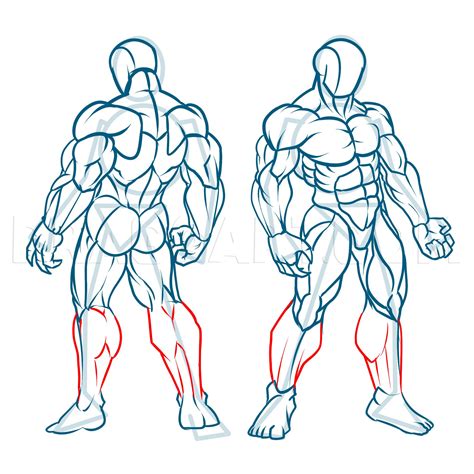How To Draw Muscles
Ronan Farrow
Feb 24, 2025 · 3 min read

Table of Contents
How to Draw Muscles: A Comprehensive Guide for Beginners and Beyond
Want to draw realistic and dynamic figures? Mastering how to draw muscles is key! This comprehensive guide breaks down the process, from understanding muscle structure to adding dynamic poses. Whether you're a beginner or looking to refine your skills, this guide will help you create compelling and anatomically accurate figures.
Understanding Muscle Structure: The Foundation of Realistic Drawings
Before you even pick up your pencil, understanding the underlying structure is crucial. Think of muscles not as isolated units, but as interconnected parts working together. This interconnectedness is what creates the fluidity and believability of your drawings.
Key Muscle Groups to Focus On:
- Torso: Focus on the rectus abdominis (abs), external obliques, and the latissimus dorsi (lats) for the back. Understanding how these interact with each other is essential for depicting movement and tension.
- Arms: Pay attention to the biceps brachii, triceps brachii, brachialis, and forearm muscles. Observe how these change shape depending on the arm's position.
- Legs: The quadriceps, hamstrings, gastrocnemius (calf muscle), and tibialis anterior are key players in leg anatomy. Their interplay creates the powerful and dynamic look of legs in motion.
- Shoulders and Chest: The pectoralis major (pecs), deltoids (shoulder muscles), and trapezius (traps) are crucial for realistic upper body depictions. Note their shape and how they attach to the bones.
Using References: Your Best Friend
Don't rely solely on memory! Use anatomical references (images, books, videos) to accurately depict muscles. Observing real-life models, or even using your own body as a reference, can be invaluable. Pay close attention to:
- Origin and Insertion Points: Muscles attach to bones at specific points. Understanding these points helps you draw their flow and form accurately.
- Muscle Shape and Volume: Muscles aren't flat; they have volume and dimension. Observe how they bulge and contract in different poses.
- Muscle Interaction: Notice how muscles overlap and interact with each other. This is crucial for a realistic depiction.
Techniques for Drawing Muscles: From Simple to Complex
Now that you have a foundational understanding, let's explore different techniques to put it all into practice.
Starting with Basic Shapes:
Begin with basic geometric shapes—cylinders, spheres, and boxes—to lay down the foundational forms of the muscles. This helps establish volume and proportion before adding finer details.
Building Up Layers:
Start with the larger muscle groups, then gradually add smaller ones on top. This layering approach adds depth and realism to your drawings. Don't be afraid to erase and redraw as you refine the shapes and forms.
Adding Shadows and Highlights:
Proper shading is vital for conveying the three-dimensionality of muscles. Pay close attention to where light hits the muscles and where shadows fall. This helps create depth and realism. Use a variety of shading techniques, such as hatching, cross-hatching, and blending, to achieve desired effects.
Practicing Different Poses and Angles:
Practice drawing the same muscles in various poses and angles. This helps you understand how their shape and appearance change based on movement and perspective. Consider:
- Tension and Relaxation: Muscles look different when tensed versus relaxed.
- Perspective: How do muscles look from different angles (e.g., front, side, back)?
- Movement: How do muscles move and interact during specific actions (e.g., lifting, bending, stretching)?
Beyond the Basics: Advanced Techniques
Once you've mastered the fundamentals, consider these techniques:
- Anatomy Studies: Deep dive into anatomical studies for more detailed understanding of muscle placement and structure.
- Gesture Drawing: Focus on the overall flow and movement of the figure before diving into the details. This helps to ensure your drawing is dynamic and engaging.
- Value Studies: Practice creating a range of values (light to dark) to add depth and realism to your drawings.
Conclusion: Practice Makes Perfect!
Drawing muscles takes time and dedicated practice. Don't be discouraged if your initial attempts aren't perfect. Consistent practice, using references, and understanding the underlying anatomy will significantly improve your ability to draw realistic and dynamic figures. Remember to have fun and keep learning!
Featured Posts
Also read the following articles
| Article Title | Date |
|---|---|
| How To Introduce Yourself Over Text | Feb 24, 2025 |
| How To Long Screenshot In Iphone 7 Plus | Feb 24, 2025 |
| How To Add Text To Canva Image | Feb 24, 2025 |
| How To Lose Weight During Periods | Feb 24, 2025 |
| How To Delete Linkedin Account Without Password Reddit | Feb 24, 2025 |
Latest Posts
Thank you for visiting our website which covers about How To Draw Muscles . We hope the information provided has been useful to you. Feel free to contact us if you have any questions or need further assistance. See you next time and don't miss to bookmark.
